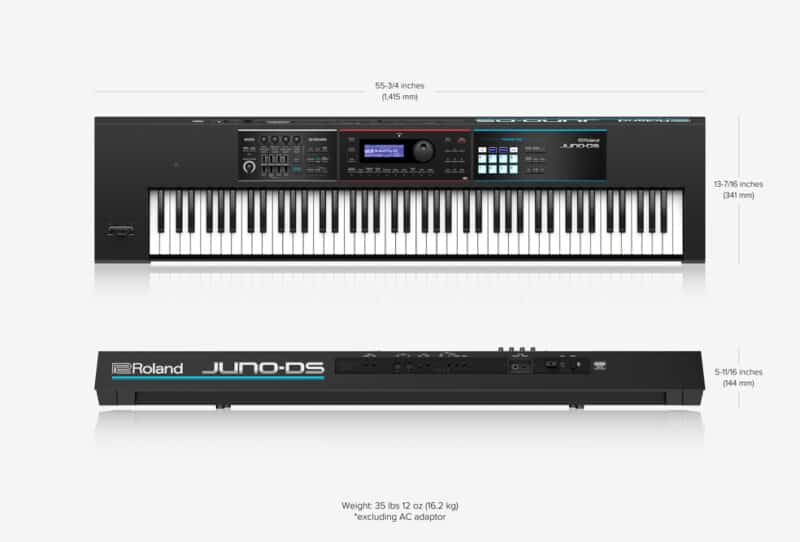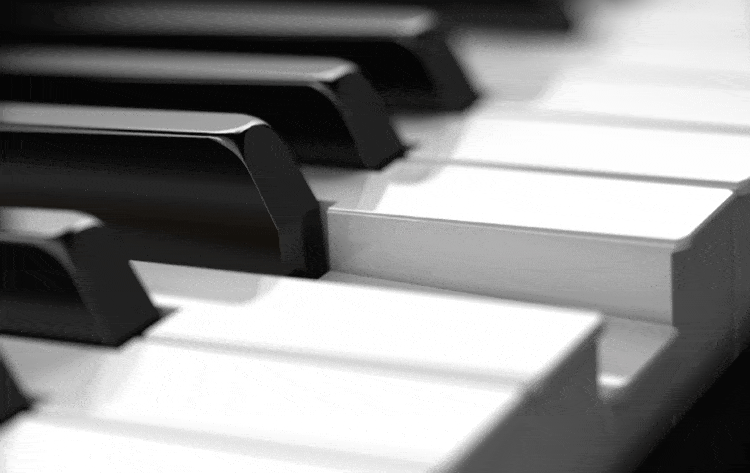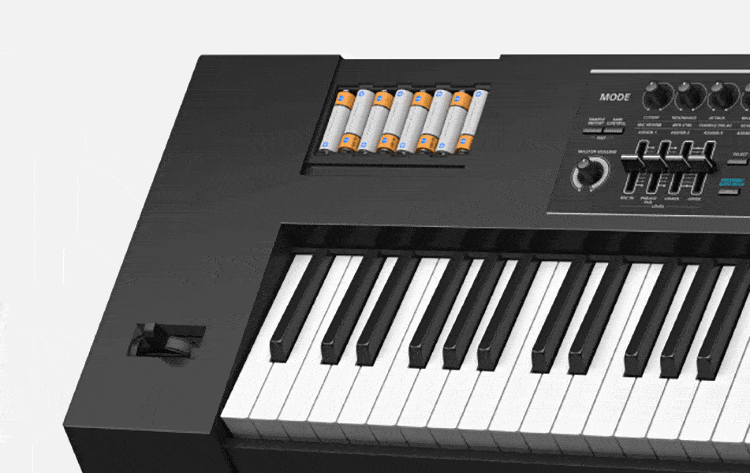As a companion piece to our unboxing video, in this article, we’ll be exploring the Roland Juno DS88 synthesizer.
This is a light and portable synthesizer that’s built primarily as a gigging instrument with stage essentials but has enough features to stimulate creativity right from the comfort of your own home, whether that’s non-stop recording of impressive vocal performances, or going to town with the intuitive eight-track pattern sequencer and multi-effects/sound effects chains.
The JUNO synths are Roland’s iconic series with a long and well-established history and are known for their ease of use, so let’s take a quick look and see how the Roland JUNO DS88 measures up upon first glance.
Roland Juno DS88 – Digital Piano Overview

As mentioned above, in this article we’ll be cracking open a brand new Roland Juno DS88, which is a full-size 88-note synthesizer with pro sounds. This is the largest model in the JUNO series, with the smaller JUNO DS76 and JUNO DS61 offered as more compact options. The Roland Juno DS88 is Roland’s mid-range synth, sitting below their flagship FA series synths.
While the DS88 isn’t a new model as it’s been on the market for several years, lately we’ve been starting to enjoy moving more into the digital and synth realms here at Merriam Music, so we thought this would be a great model to explore as we have one in stock. We’ve got our trusty scissors handy, so without further ado, let’s get this thing out of the box.
Right off the hop, it’s striking just how vintage this synth looks. In fact, the area that takes the AA batteries or rechargeable NI-MH batteries for portable use looks like an original Nintendo cartridge! The front panel includes a phrase pad, assignable faders, a host of buttons, control knobs, and an easy-to-read LCD screen, as well as real-time hands-on controls and performance features like a pitch bend wheel for serious creative command. Really, it hints at Roland’s design philosophy that you see show up in the RD-2000 and some of the other RD series from years gone by.
First Impressions
After a few minutes of playing the DS88, it’s quite reminiscent of several other Roland models, and yet, it definitely got its own distinct character, namely with regards to the control language. This is interesting, because a lot of Roland products, especially on the synth side, tend to draw on the same sort of layout designs, layout philosophies, and user interface approach. This one is certainly on the unique side, but still offers instant access to everything and some powerful enhancements like a dedicated DAW control mode and integrated USB interface.
Roland Juno DS88 Piano Action
Ivory Feel-G Keyboard with Progressive Hammer Action

The Ivory Feel-G Keyboard with Progressive Hammer Action – is the same 88-note weighted action keys as on the more expensive FA08 synth, which is a really solid action that we’re quite familiar with. It’s sort of a halfway point between the PHA4 and the high-end touch that the PHA50 action delivers. The weighting feels more like a PHA50, but the key itself looks more like a PHA4.
DS88 Onboard Piano Sounds
5x Dedicated Reverb Types
Getting into some of the onboard sounds, the top-quality acoustic piano collections are solid, the electric pianos are great, the additional organs are solid, the pads are nice and juicy and the strings are quite authentic. There’s also a solid brass section, world instruments section, and of course, the staple synth patch studio standards and over 30 drum kits. The vocoder with auto-pitch effects is something that we’ll take a closer look at in a more in-depth review. There are 5x dedicated reverb types, which is a nice addition.
128 Notes Polyphony
Juno DS88’s great sounds are thick and well-constructed, definitely good enough for professional performance, polyphony is solid at 128 notes, and the sound bank can be expanded courtesy of the Wave expansion slot via free download at Roland’s Axial website, otherwise known as internal waveform expansion or new sound waveforms. You can also load your own user WAV files via the Sample Import Function and trigger them from the keyboard’s user memory, and it’s compatible with all of the previous generation JUNO-DI patches.
The splitting capability may be a little bit basic, but it is nonetheless laid out in a very intelligent way, and we’re quite intrigued to go a little deeper with the vocoder (and its dedicated vocal reverb and electronic vocal effect), as well as the phrase pad and pattern sequencer.
DAW Controls
On the first take, this seems like a gig-ready instrument that is geared toward people who need some basic synth functionality with adjustable parameters for stage use. Maybe you’re starting to experiment with DAW control mode for use with DAWs such as Ableton, Logic, or Pro Tools for easy sound manipulation. Or really, any kind of digital environment where real-time tactile controls are something that you want to start experimenting with.
Battery-Operated

The fact that it’s battery-operated means Roland wants it to be light and portable enough to take around with you and create some music practically anywhere whenever a song idea is sparked, like in a park, on a bus, in a green room, or a small dorm room. It’s not really something targeted toward the high-end stage market, but it does look more than serviceable.
Overall Impressions
Overall, we think the DS88 is a really great instrument for the price. It’s got a lightweight design, so it’s going to be something that isn’t a burden to strap onto your shoulder and take around with you as a solo performer singer/songwriter, or producer and place on a keyboard stand.
The onboard controls are super intuitive and easy to understand – you won’t actually have to spend much time with your nose buried in a manual to get familiar with this instrument to reach a new level of performance.
The action feels great and is a tried and true staple from the Roland lineup as this premium feel is also featured in the pricier FA08 and is a good piano for the expressive new piano sounds.
The connectivity options are very solid, with staples like twin output ports, a headphone port, USB Audio (record audio songs), USB MIDI, USB memory port (USB flash drive) covered, as well as bonus ports like a Mic input and slot for an expression pedal, and of course, a power supply slot.
Thanks for reading! Visit Merriam Pianos and Stayed tuned for a much more in-depth review that might have keyboardists adding this exceptional value synth to your wishlist to aid you in making some exceptional music!
Watch more piano covers and reviews here.

